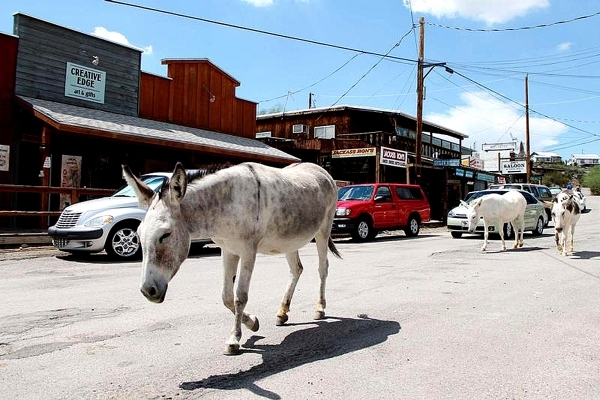Old West and Route 66 converge in Oatman, Ariz.

One of Arizona’s most popular ghost towns, Oatman thrives on tourism, welcoming crowds year-round. The former gold mining boomtown strives to provide plenty for visitors to see and do and reasons to keep them coming back. The strategy draws crowds, particularly on weekends and holidays, when it is difficult to find parking in the little desert town.
Visitors from Las Vegas reach Oatman by heading south toward the Laughlin-Bullhead City area on U.S. Highway 95, then turning on state Route 163 to the Colorado River towns, a drive of about 90 miles. Two routes access Oatman from Bullhead City, a 25-mile, unpaved scenic route using Silver Creek Road and an all-paved, 35-mile route using Arizona Route 95 south to Boundary Cone Road, east to Historic Route 66 and north to Oatman.
Visitors enjoy the town’s craggy setting near the Black Mountains and the Old West feel of weathered buildings housing about 40 shops, antiques stores, eateries, bars and ice cream parlors. The most distinctive structure on the main street, the historic Oatman Hotel, survived a devastating fire in 1921. Built in 1902 of adobe, the hotel draws visitors to its restaurant and bar, where thousands of dollar bills paper the walls. Its upstairs rooms, which once provided comforts for travelers, now display artifacts. If Oatman looks familiar, visitors may recall scenes filmed there for the 1963 Hollywood epic “How the West Was Won.”
Costumed Western characters stroll Oatman’s boardwalks, live music is featured in a few places, the Ghost Riders Gunfighters shoot it out twice a day and “wild” burros have right-of-way as they wander through town. The Oatman-Goldroad Chamber of Commerce plans fun events that bring in tourists, such as this month’s off-beat Christmas Bush Decorating along the road into Oatman, the upcoming annual bed race Jan. 30, the springtime Old Route 66 road run, the July Fourth sidewalk egg fry and frequent weekend craft shows and swap meets. Call the chamber of commerce for event details at 928-768-6222.
Oatman’s history began with promising gold discoveries in the 1860s. Slow to start, mining began in the early 1900s with new discoveries and improvements in techniques and transportation. At first called Vivian after one of the nearby mines, Oatman arose as a tent town that became more permanent as it grew.
In 1909, the town’s name was changed to Oatman after Olive Ann Oatman, a young teen from Illinois who was captured along with her sister during a Yavapai massacre of her family in 1851. Later traded to the Mohave people along the Colorado River as a slave, Olive lived among the Mohave for three years and was tattooed according to their customs. Her younger sister did not survive. Olive was eventually recovered and reunited with her surviving brother. She later finished her schooling, gave lectures on her experiences and married a Texas rancher. She died at age 65 in 1903.
After major gold strikes in 1915, Oatman boomed, growing to 3,500 residents and becoming Arizona’s richest gold producer. The major mine closed in 1924, but others continued to produce until a wartime shutdown mandated by the government in 1941. The wartime mine closures almost killed Oatman, leaving few residents. Mining enjoyed a short resurgence in the mid-1990s, and a few operations continue in the area.
Oatman survived downturns because it of its position astride U.S. 66, “The Mother Road,” the main route between Chicago and Los Angeles. Serving travelers and truckers became the old boomtown’s economic mainstay.
But in 1953, a shorter route from Kingman, Ariz., to Needles, Calif., was established. Oatman seemed doomed.
Two unrelated developments saved the old town after decades of decline. In the 1970s, the gaming and recreational destination Laughlin rose along the Colorado River, drawing thousands of tourists, many of whom also visit Oatman. In the 1980s, Historic Route 66 turned into a rolling destination, a nostalgia drive that attracts worldwide attention and more visitors. Oatman does not disappoint them.
— Margo Bartlett Pesek’s Trip of the Week column appears on Sundays.